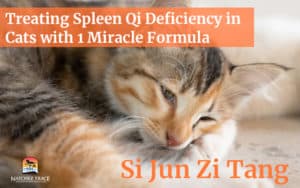Do you wish there was an all-in-one formula that works without negative side effects for dog arthritis and joint pain? If you’ve never heard of Herbsmith Di Gu Pi San, then you’re in for a treat!
Also – Dr. Smith wrote a helpful ebook about dog arthritis.
Watch this video of Dr. Smith summing up what the e-book contains and how it can help you:
The age of your dog’s decline marks the beginning of constant worry. Old-age health conditions occur, and they will most likely involve dog arthritis and joint pain. Of course, this means frequent visits to the vet, new treatments, new diet plans, hearing your pet’s heartbreaking whimpering… and the list goes on.
 Traditional Chinese Veterinary Medicine (TCVM) offers various herbal formulas to treat a variety of health conditions.
Traditional Chinese Veterinary Medicine (TCVM) offers various herbal formulas to treat a variety of health conditions.
TCVM’s philosophy revolves around extracting the disease’s underlying root. For treating the root cause of arthritis and joint pain in dogs, cats, and horses, you have Di Gu Pi San to thank.
But what is in the formula that makes it a top recommended treatment for dogs with joint pains and arthritis?
How Di Gu Pi San Works from an Eastern and Western Perspective
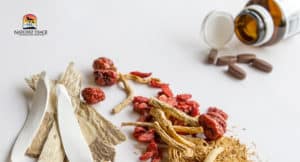 Both Western and Eastern veterinary practitioners use Di Gu Pi San. The key difference lies in the criteria they use to assess each condition. Eastern practitioners use “indicators” and Western practitioners use “diagnoses”.
Both Western and Eastern veterinary practitioners use Di Gu Pi San. The key difference lies in the criteria they use to assess each condition. Eastern practitioners use “indicators” and Western practitioners use “diagnoses”.
Eastern Usage
Eastern veterinary practitioners believe an imbalanced Qi leads to the body falling into certain health conditions. Depending on which one of the Yin or Yang is deficient or excessive, the body may react differently.
 In the context of Di Gu Pi San, the Yin is deficient. This energy is responsible for cooling and moistening (lubricating) the body.
In the context of Di Gu Pi San, the Yin is deficient. This energy is responsible for cooling and moistening (lubricating) the body.
Hence, a body deficient in Yin means there is excess heat, and the body is dry or stiff.
Here’s a list of indicators of a Yin-deficient body:
-
- Dry skin or hair coat
-
- Red, dry tongue
-
- Weak pulse
-
- Stiffness
-
- Chronic bony bi-syndrome (kidney Yin deficient)
-
- Prefers coldness
Di Gu Pi San brings back the balance by nourishing the Yin and clearing excess heat. This encourages the body to return to its original state before the condition worsens and becomes irreversible.
Western Usage
 Western veterinary practitioners, in stark contrast, rely more on diagnoses than on indicators. They treat conditions with solid findings from laboratory tests.
Western veterinary practitioners, in stark contrast, rely more on diagnoses than on indicators. They treat conditions with solid findings from laboratory tests.
They use Di Gu Pi San for these diagnoses:
-
- Hip dysplasia
-
- Arthritis
-
- Degenerative joint disease
-
- Rheumatism
-
- Chronic joint pain
-
- Intervertebral disc disease
In our experience, Di Gu Pi San proves to be one of the best hip and joint herbal supplements for dogs with arthritis pain.
If you’re considering using this formula to treat the diagnoses listed above, be sure to ask your vet beforehand.
But what exactly makes this herbal blend a miracle powder in a bottle?
8 Powerful Ingredients of Di Gu Pi San
The secret to an effective medicine lies in its composition and compound concentration. Still troubled about looking for joint and arthritis pain relief for dogs?
Here’s what makes Di Gu Pi San the most viable and safest treatment for your dog’s arthritis (it works for cats and horses, too)!
1. Cortex Lycii Radicis (di gu pi)
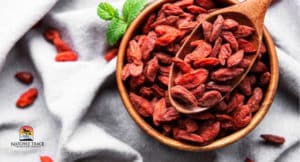 In East Asia, Di Gu Pi aids in regulating high blood pressure, alleviates body temperature, and relieves body pain and joint disorders.
In East Asia, Di Gu Pi aids in regulating high blood pressure, alleviates body temperature, and relieves body pain and joint disorders.
2. Radix Bupleuri (chai hu)
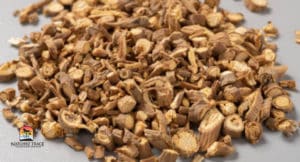 Renowned for its treatment range and anti-disease biological activities, Chai Hu disperses excess heat from the body and nourishes the Yin and Qi energy. Hence, Eastern medical practitioners use it to treat fever, influenza, malaria, menstrual disorders, and hepatitis.
Renowned for its treatment range and anti-disease biological activities, Chai Hu disperses excess heat from the body and nourishes the Yin and Qi energy. Hence, Eastern medical practitioners use it to treat fever, influenza, malaria, menstrual disorders, and hepatitis.
On the other hand, Western practitioners looked into its biological activities and discovered these effects: anticancer, anti-inflammatory, antiviral, antimicrobial, immunomodulatory, anti-fever, and promotes liver health.
3. Radix Anemarrhenae Asphodelodis (zhi mu)
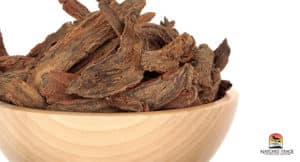 Bitter-sweet in taste and cold in character, Zhi Mu is a Yin-nourishing herbal medicine with moisturizing or lubricating properties. Thus, it helps clear heat.
Bitter-sweet in taste and cold in character, Zhi Mu is a Yin-nourishing herbal medicine with moisturizing or lubricating properties. Thus, it helps clear heat.
From a Western perspective, Zhi Mu’s properties include anti-fever, anticoagulation, antibacterial, anti-inflammatory, antiviral, and antidiabetic.
4. Honey-fried Radix Glycyrrhizae Uralensis (zhi gan cao)
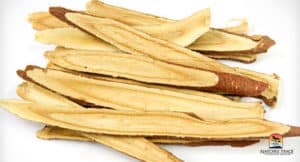 Zhi Gan Cao is a Yin-promoting, tonifying moisturizer that eliminates excess heat from the body. Categorized as a cold herb with a sweet taste, this ingredient also invigorates the qi and promotes blood circulation.
Zhi Gan Cao is a Yin-promoting, tonifying moisturizer that eliminates excess heat from the body. Categorized as a cold herb with a sweet taste, this ingredient also invigorates the qi and promotes blood circulation.
Other effects include the following: relieves cough, rids phlegm, and moderates the properties of other herbs.
Western studies focus on its anti-inflammatory, neuroprotective, and immunity-enhancing effects.
5. Carapax Amydae Sinensis (bie jia)
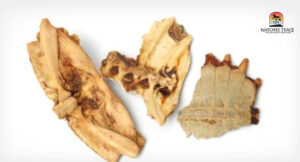 Yin-nourishing and Yang-anchoring, Bie Ja is a powerful ingredient that invigorates blood circulation. Hence, it eliminates blood stagnation while cooling down low-grade fever.
Yin-nourishing and Yang-anchoring, Bie Ja is a powerful ingredient that invigorates blood circulation. Hence, it eliminates blood stagnation while cooling down low-grade fever.
This also helps with steaming bone syndrome, thirst, alleviates heat in the palms, hands, feet, and chest, and softens hard masses on upper flank.
Western studies suggest that this ingredient shows potential viability for liver fibrosis treatment.
6. Radix Scutllariae (huang qin)
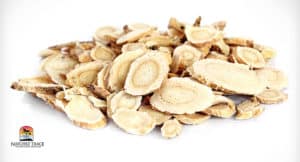 Widely used in different countries, this herbal root extract is an ingredient that helps combat cancers, inflammation, and hepatitis and other virus-related diseases. In this context, it also greatly reduces osteoarthritis symptoms.
Widely used in different countries, this herbal root extract is an ingredient that helps combat cancers, inflammation, and hepatitis and other virus-related diseases. In this context, it also greatly reduces osteoarthritis symptoms.
7. Radix Ginseng (ren shen)
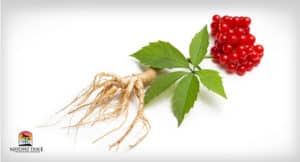 Ren Shen is a strong Qi tonifier which helps generate body fluids, alleviate thirst, tonify lungs and kidney, strengthen the spleen and stomach, restore vigor, calm the spirit, and clear the mind.
Ren Shen is a strong Qi tonifier which helps generate body fluids, alleviate thirst, tonify lungs and kidney, strengthen the spleen and stomach, restore vigor, calm the spirit, and clear the mind.
Moreover, it also aids in treating symptoms such as weak pulse, profuse sweating, shallow breathing, and cold limbs.
Western medicine uses this ingredient in kidney disease treatment. It’s also used to alleviate coronary heart diseases, malignant tumors, diabetic complications, and brain injuries.
8. Sclerotium Poriae Cocos Rubrae (chi fu ling)
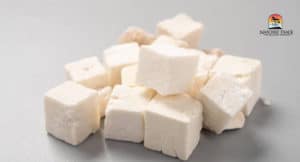 Slightly cool with a sweet and bland taste, Chi Fu Ling promotes blood circulation and eliminates blood stasis.
Slightly cool with a sweet and bland taste, Chi Fu Ling promotes blood circulation and eliminates blood stasis.
It is also used in treating a range of conditions such as memory loss, fatigue, urination problems, insomnia, spleen and stomach problems, diarrhea, and tumors.
Composed of two parts, white poria and red poria, the former calms the heart while the latter facilitates eliminating the slowing or pooling of blood.
Restoring Energetic Balance Comprehensively
 Compared to other Western pet arthritis supplements, Herbsmith’s formula brings more improved-quality-of-life benefits due to its unique combination of ingredients. The formula is targeted to promote comprehensive energetic balance restoration.
Compared to other Western pet arthritis supplements, Herbsmith’s formula brings more improved-quality-of-life benefits due to its unique combination of ingredients. The formula is targeted to promote comprehensive energetic balance restoration.
Since this formula is so targeted, you must have a veterinary authorization to purchase it. We recommend purchasing this product from TCVM Pet Supply. Your authorization can be from any vet. If you need a vet, contact us today for a consult.
On top of that, we’re offering a free comprehensive e-book guide to help you treat your pet’s arthritis that you can share with other pet parents.
Defy age with Herbsmith’s Di Gu Pi San. Try this formula to see if your pet gets relief from worsening joint pain and arthritis. No more sad puppy eyes; just a lively wagging tail excited for the outdoors.
People Also Ask:
- What are the signs that my dog might have arthritis? Dogs with arthritis often show signs such as limping, stiffness, reluctance to move or exercise, favoring certain limbs, difficulty in rising or sitting, and noticeable pain when touched in specific joints. Additionally, you might observe behavioral changes like irritability or reluctance to be touched in certain areas.
- How is arthritis in dogs diagnosed? Veterinarians typically diagnose arthritis in dogs through a combination of physical examinations and diagnostic tests. These may include observing your dog’s movement, X-rays to assess joint changes, blood tests to rule out other conditions, and sometimes joint fluid analysis to determine the extent and type of arthritis.
- What treatments are available for dog arthritis? Treatment for dog arthritis often involves a combination of approaches to manage pain and slow the progression of the disease. This may include medications like nonsteroidal anti-inflammatory drugs (NSAIDs), supplements like glucosamine/chondroitin, physical therapy, weight management, dietary changes, and sometimes surgery in severe cases.



